Understanding Keyforge: Deck Archetypes
Last week on the Keyforge discord channel I eneded up in a long discussion with another member of the community about racing decks. I realized that I haven’t seen anyone try to classify each deck archetype in Keyforge, so I thought I would give it a shot here. This is completely subjective and entirely my opinion, which may be wrong. I hope some people will at least find it useful to have a basic understanding of what people mean when they refer to these archetypes at the LGS. I have also included a short blurb at the bottom of each archetype where I give my opinion as to what sort of general matchups that archetype has against others.
Control
When playing a control deck, your goal is to slow your opponent down while you have a way of accumulating increasing value until there comes a point where your accumulated value greatly exceeds whatever they are trying to do. I refer to these accumulated value cards as scaling cards. Artifacts and creatures in Keyforge fit into this category because the longer they stay alive the more you will be able to reap or activate them.
Shards decks are some of the most archetypal control win condition cards. With one shard in play, each activation is either on par with that of another artifact or below. With each subsequent shard, the shards gain power until they are generating amazing value on each activation. In a shard deck, the longer you drag the game out for the more likely you are to hit your three shards. You’re much more likely to win if you can activate each shard 4 times for the triple shard bonus.
This is what a shard-based control deck might look like:
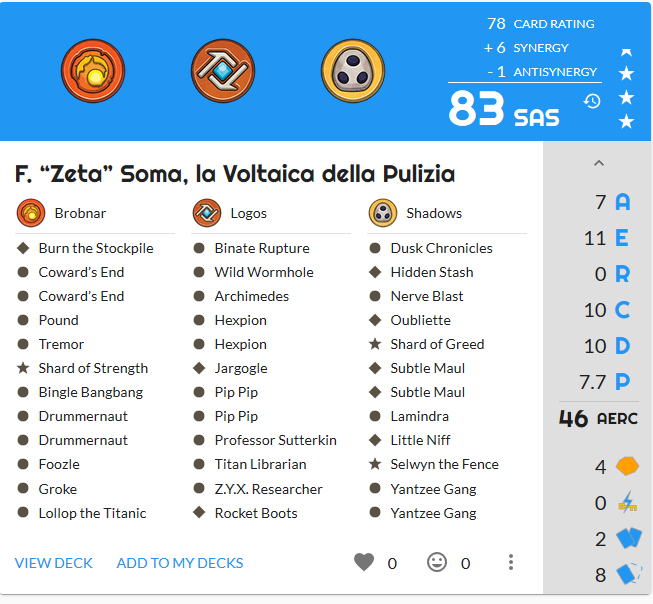
This deck has removal to slow the opponent in the form of Coward’s End and Oubliette, aember control from Little Niff and Burn the Stockpile, and scaling win conditions in the form of the shards, Titan Librarian, and the double Subtle Maul.
Under the umbrella of control, there are two main sub-archetypes: board control and aember control.
Board Control
Board control decks rely on using fighting and reaping to get ahead. A board control deck denies its opponent resources and slows the game down through fighting, and generates large amounts of aember consistently once it has established a very large and intimidating board.
In board control decks the scaling win conditions are usually creatures with powerful passive or reap abilities that can be activated multiple times without threat due to the constant fighting presence of other creatures, or through the protection of creatures like Shadow Self or large taunt units. Creature based combos are also quite reliable in board control decks because the chances of the combo pieces dying is much lower. The Ganger Chieftain/Drummernaut combo and the double Grey Rider combo both are much more consistent in board control decks.
This deck is an example of what a board control deck looks like:
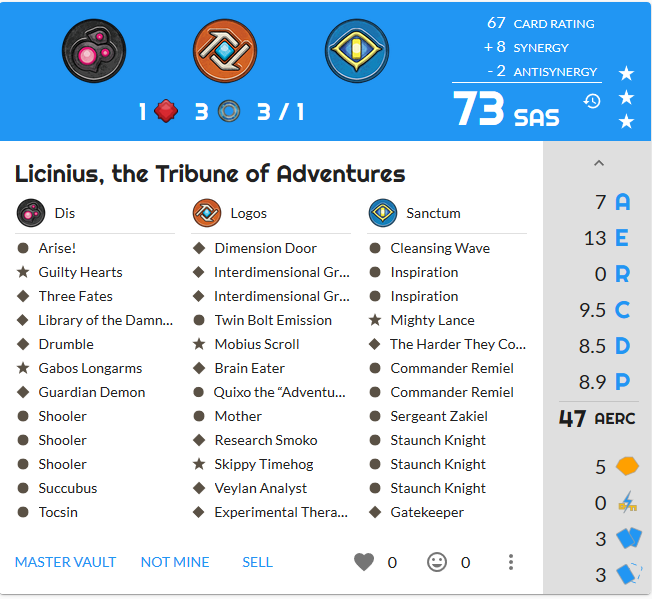
This deck has a whopping 21 creatures, using the brute force of these bodies to muscle the opponent out of the game. In this deck the scaling win conditions are double Commander Remiel, the Succubus and the Tocsin as they all generate a ton of value as the game goes on. Guardian Demon and Cleansing Wave are also great in this deck due to the constant fighting, generating even more value from your board.
Matchups:
VS. Aember control
Aember control decks have a hard time dealing with board control decks because most board control decks don’t generate much aember for the aember control decks to steal or destroy. By the time the board control deck has established a proper setup, the deck can reap consistently for 6 or more aember a turn, generating too much aember for the aember control deck to deal with.
VS. Rush
Rush decks annihilate board control decks because there are so many incidental cards that mess with creatures in Shadows and so many strong boardwipes in other houses. Rush decks are too fast for board control decks to deal with. By the time a board control deck gains a large enough board to start reaping, most rush decks have already won or are halfway to their third key.
VS. Tempo
Tempo decks are usually quite hard to pilot and require the player to know when to switch from more of a rush style to more of a midrange style. A properly piloted tempo deck should be able to wipe the floor with a board control deck if it gets to go first and establish a board before the board control deck, but similar to midrange the matchup does come down to the decks and the players.
VS. Combo
Board control decks will have to race against combo decks and hope that the opponent does not draw the combo before they can establish a huge board. Board control decks will usually beat creature based combo decks but struggle against the more action-oriented combo decks. Like with tempo and midrange though, it does come down to the individual deck and the secondary and tertiary archetypes present.
Aember Control
Aember control decks mess with the opponent’s aember more than the board, preferring to rely on stealing away aember to win or slowing the opponent down enough with aember destruction to win through a combo or recurring value through artifacts like Subtle Maul or the shards.
Here is an example of a aember control deck:
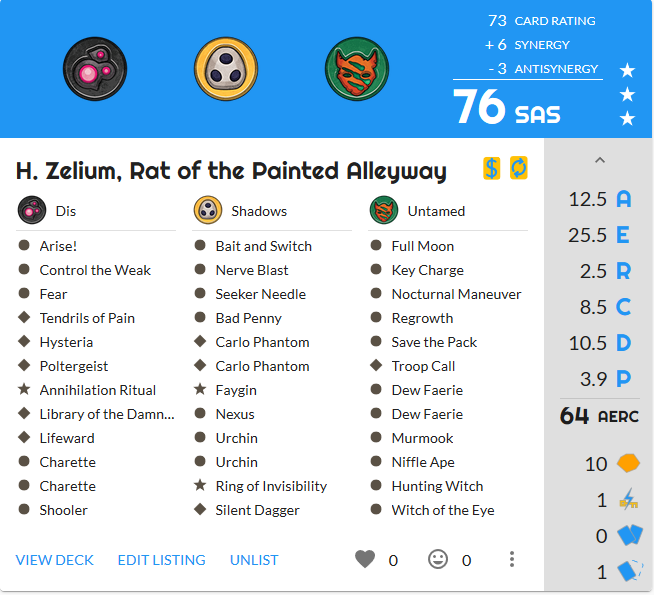
This deck wins through messing with the opponents aember through Bait and Switch, Charette, and Faygin/Urchin shenanigans, hoping to burst a ton of aember in one turn with a Hunting Witch/Full Moon combo from Untamed, or through the double Carlo Phantom stealing aember over time.
Matchups:
VS. Board Control
Aember control decks have a hard time dealing with board control decks because most board control decks don’t generate much aember for the aember control decks to steal or destroy. By the time the board control deck has established a proper setup, the deck can reap consistently for 6 or more aember a turn, generating too much aember for the aember control deck to deal with.
VS. Rush
Aember control decks will eat rush decks for breakfast. Aember control decks inherently counter what rush decks are trying to do, especially in a steal heavy aember control deck. The only way a rush deck can beat a aember control deck is if the rush deck has heavy aember control itself or has a combo element and can win through something like a Key Charge.
VS. Tempo
Another skill based matchup. Tempo players absolutely must establish board early and fight to keep board control, hoping to force the aember control player to call houses at innoportune times to steal or remove aember. Tempo decks can take this matchup down but aember control is favored here.
VS. Combo
Aember control decks have a hard time playing against combos that forge keys as part of the combo, but don’t have as much of an issue with creature based combos. Deck dependent as the combo player must judge when it is safe to go off and the aember control player must judge when they should be afraid of a combo turn, but overall I would bet that combo decks win this matchup more often than not.
Rush
Rush decks are the aggro decks of Keyforge. The goal is to pressure the opponent with tons of raw aember generation. A rush deck must have enough expected aember to forge all three keys without having to reap once with creatures. Rush decks play differently from the other archetypes because all the effects of your cards are almost secondary to the aember itself. You go fast, make aember, and brute force your way through to victory. A good rush deck can make around 3 aember a turn with relative consistency, pressuring the opponent to make suboptimal plays to stop you.
This is an example of a rush deck:
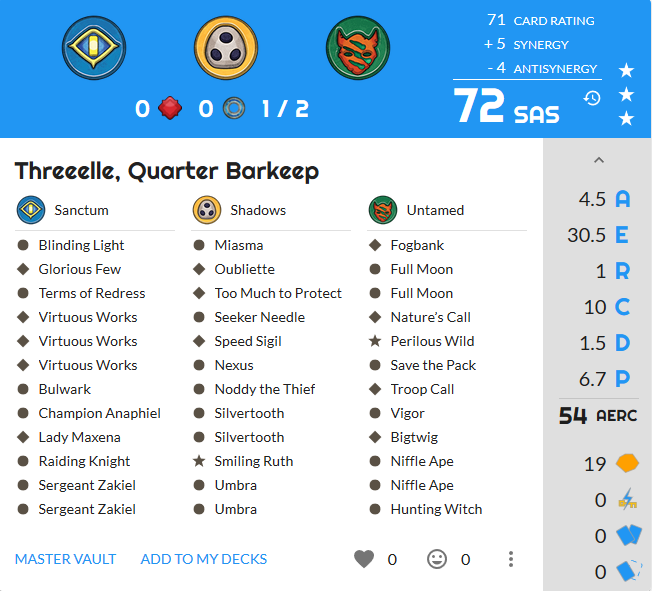
This deck has triple Virtuous Works, probably the strongest card in the game for aember generation. Speed Sigil is perfect for this deck as it helps turn all of your creatures into raw aember pips and this deck can slow your opponent down a little with Blinding Light and Nature’s Call while pumping out the massive 30.5 expected aember.
Matchups:
VS. Aember Control
Aember control decks will eat rush decks for breakfast. Aember control decks inherently counter what rush decks are trying to do, especially in a steal heavy aember control deck. The only way a rush deck can beat a aember control deck is if the rush deck has heavy aember control itself or has a combo element and can win through something like a Key Charge.
VS. Board Control
Rush decks annihilate board control decks because there are so many incidental cards that mess with creatures in Shadows and so many strong boardwipes in other houses. Rush decks are too fast for board control decks to deal with. By the time a board control deck gains a large enough board to start reaping, most rush decks have already won or are halfway to their third key.
VS. Tempo
Tempo decks will usually beat rush decks because while they are just slightly slower than rush decks, the additional threat of creatures and other strong interactions gives Tempo decks a leg up if they can make the game last an extra turn or two longer.
VS. Combo
Rush decks will usually be able to go faster than combo decks, but there is always a chance for the combo deck to get lucky and draw into the combo. Creature based combos are usually stronger against rush decks because it is easier to maintain board control to fully execute them.
Midrange
Midrange decks want to hit a balance between rush decks and control decks. A good midrange deck can go over a rush deck with control cards and establish value plays, while against a slower deck will power out aember and win before the opponents engines go online. Midrange decks want a mix of everything, and most Keyforge decks will fall solidly in this category.
This is an example of a midrange deck:
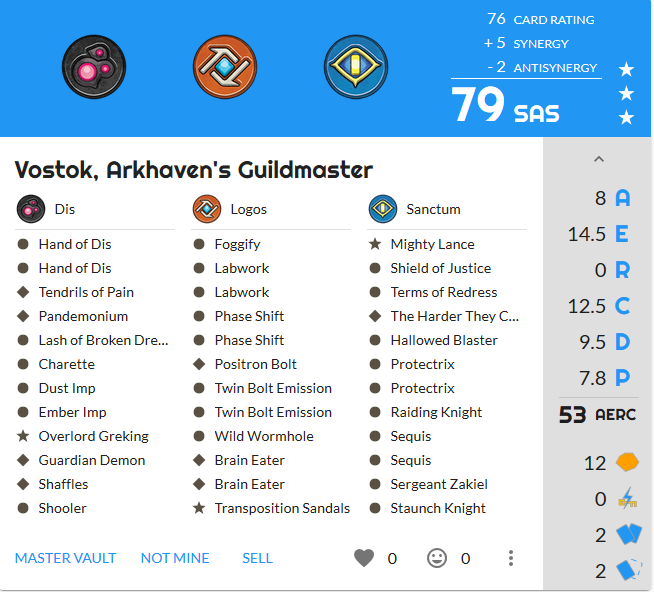
This deck has a balance of removal, powerful scaling cards, aember control and aember generation to play a wide variety of playstyles and play to the weaknesses of the opponent. If you can protect the Shaffles this deck will beat the rush decks, and if you reap early and go for aember generation you have a good chance of beating a board control deck.
Matchups
Midrange decks don’t have any distinct matchups because they are a balance of all the archetypes. Each matchup will be based off the individualities of the list, strengths of the player, and the heart of the cards.
Tempo
Tempo is a harder archetype to define because even in other games like MTG it is hard to find a concise, agreed upon definition. I think of the tempo archetype as a deck style that generates a source of pressure early, protects that pressure, and powers out burst in the endgame to win. If a tempo deck gets ahead early they can abuse that advantage and rip the opponent apart. If they get shut down at the beginning of the game, however, the deck usually has a motley crew of suboptimal cards without enough raw aember to win. I love playing tempo decks because they can be very skill intensive while retaining that optimized and fast feel of rush decks.
This is my favorite tempo deck:
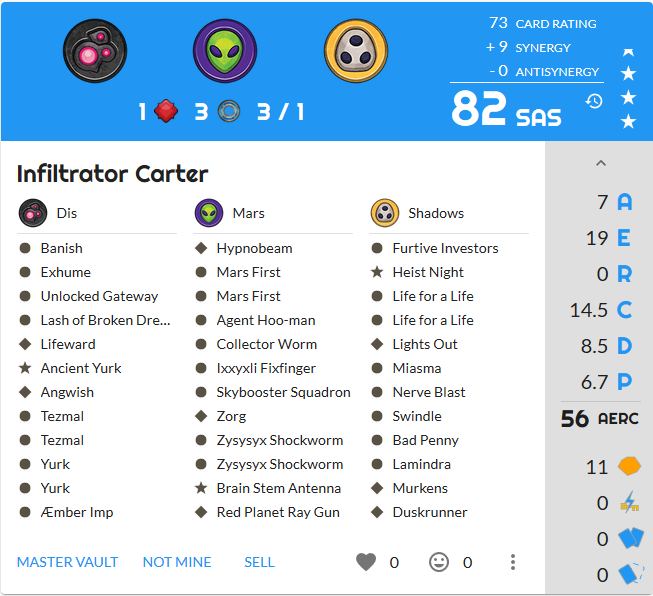
The deck can cycle quickly with the Yurk cards, can mess with the opponent through double Tezmal and the double Zysysyx Shockworm, and after reaping in the early game can win through the 19 expected aember.
Matchups
VS. Tempo
Another skill based matchup. Tempo players absolutely must establish board early and fight to keep board control, hoping to force the aember control player to call houses at innoportune times to steal or remove aember. Tempo decks can take this matchup down but aember control is favored here.
VS. Board Control
Tempo decks are usually quite hard to pilot and require the player to know when to switch from more of a rush style to more of a midrange style. A properly piloted tempo deck should be able to wipe the floor with a board control deck if it gets to go first and establish a board before the board control deck, but similar to midrange the matchup does come down to the decks and the players.
VS. Tempo
Tempo decks will usually beat rush decks because while they are just slightly slower than rush decks, the additional threat of creatures and other strong interactions gives Tempo decks a leg up if they can make the game last an extra turn or two longer.
VS. Combo
Similar to rush vs. combo, tempo decks are favored because they can go faster than the opponent. Creature based combo decks are usually weaker against tempo decks though because tempo decks can usually play for board somewhat, while more impactful combos are very strong against tempo because there is a higher chance of drawing the combo.
Combo
I covered combo decks in a previous article, and if you would like to hear more about combo decks I recommend you check that article out, as I wont go into them in detail here.
No deck in Keyforge will be one specific archetype, and most of them will have aspects of each thrown in. One of the best parts about this game is that each deck is completely unique and will always respond differently to different opponents because each opponent will also always have a mix of archetypes. Boot up https://www.thecrucible.online/ and play some Keyforge to figure out where your deck fits and what matchups are good for your deck!